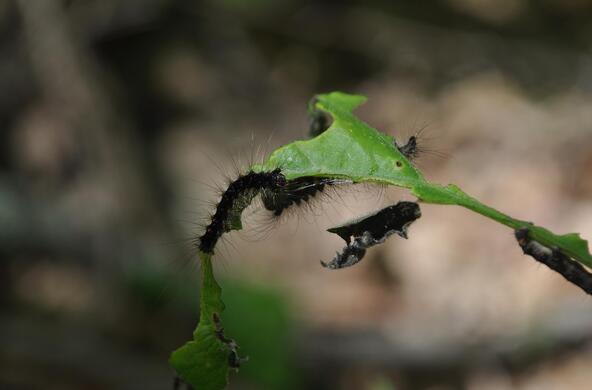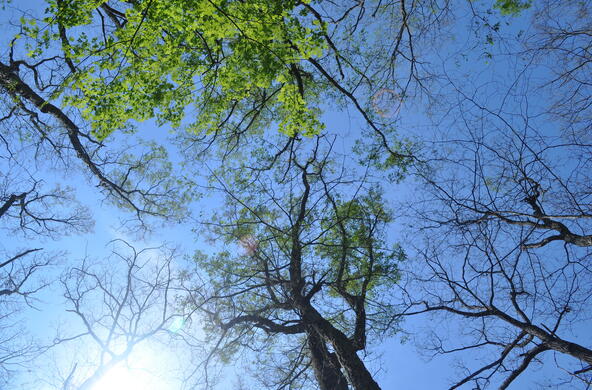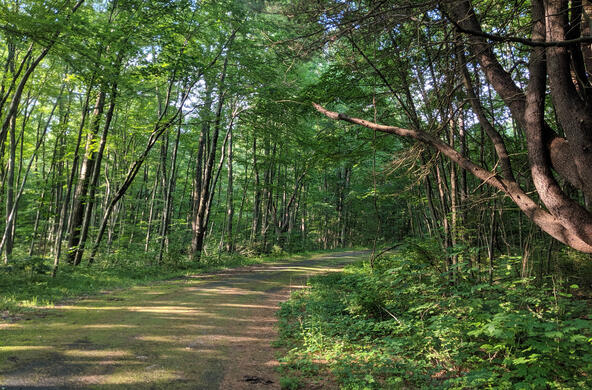This spring, Cary Institute of Ecosystem Studies hosted ‘Saving Our Trees: Preventing Imported Forest Pests’ – a virtual panel discussion moderated by journalist Gabriel Popkin that featured Faith Campbell from the Center for Invasive Species Prevention, Susan Frankel from the USDA Forest Service, and Gary Lovett from Cary Institute.
During the panel discussion, listeners submitted questions. Due to time constraints, not all were answered live. The panelists collaborated to address these questions; their responses are below. If you missed the program, you can watch the video online.
Other forest pests
Q. Are we exporting North American pests to other continents?
A. Yes, trade flows globally and so does the inadvertent transport of forest insects and pathogens. However, it appears that the US imports more forest pests than it exports. A few examples of North American forest pests causing damage overseas include:
- Pine wood nematode (Bursaphelenchus xilophilus, vector Monochamus spp.), which has caused considerable damage in Asia and has recently been introduced into Spain and Portugal (the latter introduction possibly in wood packaging).
- Canker stain of plane (Ceratocystis platani), a fungus that is killing plane trees (Platanus) from France to Iran. Its introduction has been attributed to wood packaging used by the US army during World War II.
- Red turpentine beetle (Dendroctonus valens), which is causing unprecedented tree mortality in China, where it was introduced in the early 1980s when unprocessed logs were imported from the West Coast of the US.
- Phytophthora pluvialis, a plant pathogen which was introduced into New Zealand (most likely on nursery plants imported from the US) where it is damaging radiata pine (Pinus radiata).
- Fall webworm (Hyphantria cunea), which is a minor nuisance in North America but has become a very damaging defoliator in China and elsewhere in Asia. In China, this insect is known as the American white moth.
Q. Why were serious native forest pests such as pine bark beetles and spruce budworm not discussed during your recent talk, ‘Saving Our Trees: Preventing Imported Forest Pests’?
A. The focus of this discussion was imported forest pests, so we did not discuss native forest pests and pathogens. Many native forest pests, such as western bark beetles, are very damaging to native forests, and the scope and intensity of their outbreaks are increasing due to climate change. But for this session, we wanted to call attention to damaging imported pests – which can be prevented if the pathways for introduction are shut down. We hope to increase awareness for the need to prevent new pest and pathogen introductions.
Biological control of forest pests
Q. In approving biocontrol agents, have we gone from too lax to too cautious?
A. It is true that much greater care is now taken in analyzing potential biocontrol agents before they are released. We have few control options for the hundreds of forest pests that are widespread, so this option should be explored. So far, however, few biocontrol programs have provided the necessary level of protection to the host trees. And the effects of biocontrol agents can be difficult to predict because they can evolve when released into new environments.
Q. In some areas, beetles have been deployed as a biological control agent against hemlock woolly adelgid (HWA). Has this method been effective? Is it still in the ‘experimental’ phase, or is it now an accepted form of remediation?
A. The biocontrol of HWA is promising but still not certain. It is hoped that a combination of two beetle species – Laricobius osakensis from Japan and L. nigrinus from western North America – can provide the necessary level of protection. In addition, silverflies from the genus Leucopis are sometimes used to supplement the beetles because they attack the HWA at a different life stage. To date, we don’t know of any areas where the biocontrol insects have been able to control outbreaks of HWA.
Q. What is the black, winged insect that you showed while talking about biological control during your panel discussion ‘Saving Our Trees: Preventing Imported Forest Pests’?
A. Tetrastichus planipennisi is a non-stinging wasp native to North Asia. It is a parasitoid of the emerald ash borer, an invasive insect that attacks ash trees, and is being used in experimental trials for biological control of that insect.

Protecting trees
Q. How can I protect my hemlocks from hemlock woolly adelgid?
A. If the tree is accessible by spray truck, a dormant oil (a relatively safe insecticidal treatment), can be applied. Some insecticides can be injected into the trees; this method is used to treat both hemlocks (for HWA), and ash, which are attacked by the emerald ash borer.
However, the most commonly used insecticide, imidacloprid, is a neonicotinoid, which can harm beneficial insects as well as pests. Please consult your state’s extension service for advice on using insecticides. Be cautious about relying on commercial tree services for advice.
For most forest trees, the use of insecticides is too expensive and dangerous to undertake, so those trees are unprotected.
Prospects for eradicating forest pests
Q. Has any imported pest within the US been 100% eradicated? If not, what is Plan B?
A. Some relatively restricted outbreaks of pests have been eradicated; however, this can come at great cost. Examples include the eradication of Asian longhorned beetle outbreaks in Chicago, Boston, Toronto, and in several boroughs of New York City. Unfortunately, once a pest has spread widely, eradication is no longer possible. At that point, the goal shifts to controlling the insect population to slow its spread and minimize damage. This is why it is critical to keep pests out of the country and undertake proactive surveillance measures to detect outbreaks while they are still small.
Q. Has the genetic technique of CRISPR been considered as a strategy to eradicate a pest such as the emerald ash borer on a continental scale?
A. CRISPR is a promising molecular tool. Scientists are exploring ways to use CRISPR to speed up and improve breeding of resistant plants, as well as other pest fighting applications. However, these technologies are not far enough along to completely eradicate a pest.
We do not know of any current research efforts attempting to use CRISPR to alter the genetics of a pest in a way that would reduce its population.
Wood packaging and alternatives
Q. Is the wood used to build packing cases in China being imported from the US?
A: No. Chinese exporters make their own packing cases from wood grown in China, which is a concern. Wood from China may contain larval beetles – including Asian longhorned beetle, emerald ash borer, velvet longhorned beetle, and others.

Q: Why don’t we set a deadline for phasing out the use of solid wood packaging?
A: This would be the most effective solution for the problem of pests imported in wood packaging. Cary Institute has called for a shift to pest-free packaging in its ‘Tree-SMART Trade’ policy recommendations (www.treesmarttrade.org ). This is a difficult problem because most international shipments use crates and pallets, and the vast majority of those crates and pallets are made of solid wood; phasing it out would cause a major disruption to current shipping practices. It would require a large public outcry to convince governments that making this change is important.
It is worth noting that switching to non-wood packing materials would affect more than just the shipping industry. Pallets are important to the wood products industry because they provide a market for low-grade wood that cannot be used for lumber, furniture, etc.
Q. Why can’t we use pallets made of alternative materials, such as plywood, recycled plastic, or bamboo?
A. There are already pallets on the market made of recycled plastics, manufactured wood products such as plywood and OSB, and other materials. We do not know of any made of bamboo, but that is worth looking into! However, these alternative materials constitute a very small percentage of the international pallet market. They tend to be somewhat more expensive than solid wood, and companies are always trying to reduce costs. Pallets made from recycled plastic would provide a durable use for the mountains of plastic being generated in the world.
Unfortunately, the ultimate cost of using solid wood is paid by those who lose trees to the insects imported in wood packaging. There are also ecological costs – to forests and other natural ecosystems.
Inspection
Q. Given the vast quantity of imports, thorough inspection of live plants and other goods is challenging. Could sniffer dogs help identify infested plants or other stowaway pests?
A. Sniffer dogs are being used domestically to search live plant shipments at cargo and passenger terminals. ‘Electronic noses’ are being investigated as a way to detect plant disease problems including citrus greening, turfgrass diseases, and others.
Researchers are also conducting trials that use dogs to identify plants infected with the sudden oak death pathogen – to assist not only inspectors, but nursery growers and others interested in preventing infection and movement of plant pathogens.

Q. Can we use new technologies to find pests?
A. Researchers are investigating ways to use vibrations, airborne chemicals, and DNA to find pests in wood packaging, plants, and the environment. We can expect these technologies to improve in coming years, leading to more efficient cargo inspection. Still, the amount of incoming cargo is enormous, and these technologies can’t be implemented without opening individual shipping containers – which is time and labor intensive. The best solution: keeping pests out of the wood (or keeping the wood out of the cargo).
Q. When we find infested shipments, can we track them back to their origins?
A. International regulations governing wood packaging pest treatment require wood to be stamped with a number that identifies where it was treated against pests. However, the trace-back procedure is cumbersome, and we cannot enforce laws in other countries. This problem could be alleviated if the US government provided more information about shipments found to be infested. Releasing this information publicly would allow private companies to make better choices about where they get their packaging material. Another important step that could reduce pest introductions: levying tougher penalties for repeat violators of wood packaging regulations.
A recent positive development is that US Customs and Border Protection, which does cargo inspections at ports, has started a program that allows companies expedited passage through customs if they adhere to strict procedures for keeping pests out of their wood packaging material. This provides a tangible incentive for importers to clean up their supply chains.
Plants as vectors
Q. Why do we import so many plants? Why not use more native species?
A. We import plants primarily because it is cheaper to grow them overseas, where labor costs are lower. Also, gardeners often want to try new plant varieties – which can be met by importing plants native to other continents. We agree that it is better to use US-grown plants.

Q. How can landowners make safe decisions when purchasing plants? Can you suggest informational resources?
A. This is difficult. It is best to buy plants from a local nursery – not over the internet or from a ‘big box’ store. You can get to know your local nursery staff and learn about where they get their plants. Ask them if they are participating in the Systems Approach for Nursery Certification (SANC) program that helps ensure pest-free nursery plants. For more info: https://sanc.nationalplantboard.org/.
Impacts
Q. Can you comment on the impacts of Dutch elm disease on urban streetscapes?
A. Dutch elm disease, caused by fungi in the genus Ophiostoma, is one of the most destructive diseases of woody trees. Over the last century, elms have suffered major losses worldwide, with the near-total disappearance of adult trees in many areas of Europe, Asia, and North America. The destructiveness and severity of this disease are mainly due to the rapidity and efficiency of its spread via elm bark beetles. This pathogen entered the US on shipments of unpeeled veneer logs from Europe. Dying American elms were first observed in Cleveland, Ohio in 1930; the disease has now spread across much of the US. Elms were widely planted as urban street trees, and their loss was devastating to many cities. Unfortunately, many cities chose ash trees to replace the elms; those ash trees are now dying from the emerald ash borer.
Q. Do intact, undisturbed forests have a better chance of building resistance to such pests?
A. There is no evidence that undisturbed forests are less vulnerable to pest invasions than disturbed forests. Tree resistance develops as a slow evolutionary response to exposure to a pest or pathogen; this evolutionary process operates in both intact and disturbed forests. Some pests are transmitted by humans (on vehicles, on hiking boots, in firewood, etc.), so forests visited by fewer people are less susceptible to this kind of exposure. Because many pests and pathogens affect a single tree species or genus, forests that are more diverse (with more kinds of trees) would be less severely impacted, since fewer trees would be affected.
Q. Does the presence of an insect’s native host (for instance, the tree Ailanthus and the spotted lanternfly) make it easier or harder to deal with?
A. This situation is mixed. On the one hand, if Ailanthus did not exist in the US, we probably wouldn’t have a lanternfly problem. This is because the lanternfly requires Ailanthus during one phase of its life cycle. Since Ailanthus is so widespread, it facilitates rapid spread of the lanternfly.
On the other hand, knowing that Ailanthus and lanternflies often coexist can help authorities focus detection surveys on sites where Ailanthus is present. (Bearing in mind that the lanternfly will feed on other trees, shrubs, and vines – so focusing exclusively on Ailanthus does not ensure an adequate survey.) They can also use Ailanthus as ‘trap trees’. Removing all but a few Ailanthus in an area forces local lanternflies to congregate on those few trees during the required life stage. Targeted insecticide treatments can then be used to kill lanternflies on those trees.
Disposing of infested wood
Q. How can I safely dispose of the wood from ash trees that have died from emerald ash borer?
A. The best way to ensure that you are not spreading pests is either to have the wood chipped and use it as mulch in your yard, or burn it in a fireplace at your home. It is important to keep the wood where the tree died.
Climate change
Q. How does climate change affect insect pest and disease outbreaks in forests, and what mitigation options do we have?
A. Climate warming can allow both native and invasive pests to expand their range and attack new areas. Good examples in the US are the invasive hemlock woolly adelgid, and two native pests – southern pine beetle and mountain pine beetle. Climate change can also weaken trees and make them more susceptible to pests. In some cases, climate change is providing conditions that favor certain pathogens, such as Swiss needle cast damage in the Pacific Northwest, and Dothistroma needle blight in British Columbia.
Various techniques are being employed to sustain threatened plant populations. These include methods like planting a variety of species in reforestation efforts, and relocating at-risk plant species to more favorable areas or sites predicted to be hospitable under future climate conditions.
The other side of the climate change coin is that insect and disease damage can reduce the carbon sequestration capacity of forests, thus limiting their ability to absorb the carbon dioxide that we release into the atmosphere. Reducing the global forest carbon sink will exacerbate climate warming and its effects.
Detecting and eradicating outbreaks
Q. Can we do a better job at eradicating new invasive species near ports?
A. The USDA and individual states work together to try to detect new invasive species near ports and other places of entry. One component of these efforts is the Cooperative Agriculture Pest Survey (CAPS). Unfortunately, pests can slip through and spread before they are detected.
Most pest outbreaks are detected not by monitoring networks, but by alert citizens who notice something unusual on a tree. If an outbreak is small, eradication is usually feasible. However, if an outbreak is undetected and spreads widely, eradication becomes impossible. Funding to eradicate newly detected pests is more readily available for pests known to threaten agricultural crops than for those that attack forest trees. When a new pest is detected, it is often unclear what level of threat it presents. Lacking certainty, officials often hesitate to take action.

Other pathways
Q. Can imported foodstuffs and produce carry pests and pathogens?
A. Imported fruits and vegetables can introduce both insects and disease pathogens. Typically, those pests pose a greater risk to US food crops than forest trees. The USDA regulates imports of fruits and vegetables more aggressively than it does horticultural plants, which are more likely to transmit pests and diseases to forest trees.
Want to hear more from these experts?
Watch a a panel discussion ‘Saving Our Trees: Preventing Imported Forest Pests’ where more questions are answered.







